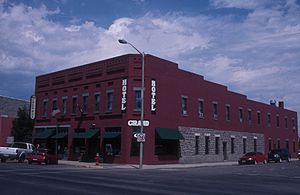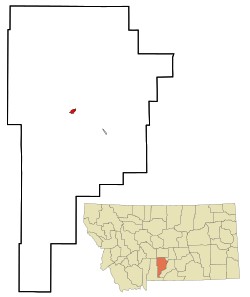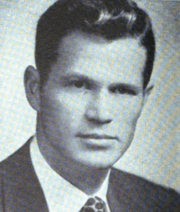Big Timber, Montana facts for kids
Quick facts for kids
Big Timber
|
|
|---|---|

Grand Hotel
|
|

Location of Big Timber, Montana
|
|
| Country | United States |
| State | Montana |
| County | Sweet Grass |
| Government | |
| • Type | Mayor Council |
| Area | |
| • Total | 0.98 sq mi (2.53 km2) |
| • Land | 0.98 sq mi (2.53 km2) |
| • Water | 0.00 sq mi (0.00 km2) |
| Elevation | 4,095 ft (1,248 m) |
| Population
(2020)
|
|
| • Total | 1,650 |
| • Density | 1,688.84/sq mi (651.84/km2) |
| Time zone | UTC−7 (Mountain (MST)) |
| • Summer (DST) | UTC−6 (MDT) |
| ZIP code |
59011
|
| Area code(s) | 406 |
| FIPS code | 30-06475 |
| GNIS feature ID | 2409846 |
Big Timber is a city in Montana, United States. It is also the main town, or county seat, of Sweet Grass County. In 2020, about 1,650 people lived there.
The city got its name from Big Timber Creek. William Clark, a famous explorer, named the creek because of the many large cottonwood trees he saw there. Big Timber started as a post office in 1880. It became an important stop on the Northern Pacific Railroad, especially for shipping wool. In 1895, it became the county seat. A big fire in 1908 destroyed many buildings in the town.
Contents
Geography
Big Timber covers about 2.5 square kilometers (0.95 square miles). Most of this area is land, with a small amount of water.
Climate
Big Timber has a cool, dry climate, but it's also close to a climate with humid summers.
- Winters: Winters can be very cold. However, warm winds called chinook winds often blow through. These winds can make temperatures rise above 10°C (50°F) even in winter.
- Spring: Spring is usually windy. Thunderstorms become more common in late spring and early summer. These storms bring most of the yearly rain.
- Summers: Summer days can be very hot, sometimes reaching over 37°C (100°F). The hottest temperature ever recorded was 43°C (110°F) in July 1931.
- Fall: Fall is usually short and can have changing weather. Sometimes it snows in September, but other times warm weather lasts until October or November.
| Climate data for Big Timber, Montana, 1991–2020 normals, extremes 1894–present | |||||||||||||
|---|---|---|---|---|---|---|---|---|---|---|---|---|---|
| Month | Jan | Feb | Mar | Apr | May | Jun | Jul | Aug | Sep | Oct | Nov | Dec | Year |
| Record high °F (°C) | 78 (26) |
72 (22) |
80 (27) |
89 (32) |
97 (36) |
106 (41) |
110 (43) |
107 (42) |
100 (38) |
88 (31) |
78 (26) |
80 (27) |
110 (43) |
| Mean maximum °F (°C) | 56.1 (13.4) |
58.7 (14.8) |
68.0 (20.0) |
77.0 (25.0) |
84.0 (28.9) |
92.0 (33.3) |
97.5 (36.4) |
96.3 (35.7) |
91.3 (32.9) |
80.0 (26.7) |
65.6 (18.7) |
56.4 (13.6) |
98.3 (36.8) |
| Mean daily maximum °F (°C) | 38.1 (3.4) |
40.0 (4.4) |
49.3 (9.6) |
56.8 (13.8) |
66.6 (19.2) |
75.8 (24.3) |
86.2 (30.1) |
84.9 (29.4) |
74.1 (23.4) |
59.0 (15.0) |
45.9 (7.7) |
37.2 (2.9) |
59.5 (15.3) |
| Daily mean °F (°C) | 28.8 (−1.8) |
29.8 (−1.2) |
37.7 (3.2) |
44.6 (7.0) |
53.4 (11.9) |
61.9 (16.6) |
69.8 (21.0) |
68.1 (20.1) |
58.8 (14.9) |
46.7 (8.2) |
35.9 (2.2) |
28.4 (−2.0) |
47.0 (8.3) |
| Mean daily minimum °F (°C) | 19.5 (−6.9) |
19.6 (−6.9) |
26.0 (−3.3) |
32.4 (0.2) |
40.3 (4.6) |
47.9 (8.8) |
53.5 (11.9) |
51.3 (10.7) |
43.4 (6.3) |
34.4 (1.3) |
26.0 (−3.3) |
19.5 (−6.9) |
34.5 (1.4) |
| Mean minimum °F (°C) | −10.8 (−23.8) |
−6.3 (−21.3) |
2.3 (−16.5) |
17.2 (−8.2) |
26.6 (−3.0) |
36.8 (2.7) |
44.3 (6.8) |
40.2 (4.6) |
30.1 (−1.1) |
14.3 (−9.8) |
0.3 (−17.6) |
−7.4 (−21.9) |
−20.5 (−29.2) |
| Record low °F (°C) | −36 (−38) |
−47 (−44) |
−32 (−36) |
−10 (−23) |
10 (−12) |
26 (−3) |
33 (1) |
28 (−2) |
12 (−11) |
−14 (−26) |
−29 (−34) |
−38 (−39) |
−47 (−44) |
| Average precipitation inches (mm) | 0.73 (19) |
0.65 (17) |
0.98 (25) |
2.18 (55) |
3.06 (78) |
2.63 (67) |
1.38 (35) |
0.99 (25) |
1.31 (33) |
1.51 (38) |
0.78 (20) |
0.73 (19) |
16.93 (431) |
| Average snowfall inches (cm) | 7.1 (18) |
10.8 (27) |
9.1 (23) |
3.6 (9.1) |
0.6 (1.5) |
0.0 (0.0) |
0.0 (0.0) |
0.0 (0.0) |
0.5 (1.3) |
4.8 (12) |
7.9 (20) |
10.2 (26) |
54.6 (137.9) |
| Average precipitation days (≥ 0.01 in) | 4.7 | 4.4 | 6.1 | 8.6 | 11.4 | 10.6 | 7.5 | 5.4 | 6.3 | 7.2 | 4.9 | 4.4 | 81.5 |
| Average snowy days (≥ 0.1 in) | 2.6 | 3.1 | 2.1 | 1.3 | 0.1 | 0.0 | 0.0 | 0.0 | 0.2 | 1.2 | 2.2 | 2.4 | 15.2 |
| Source 1: NOAA | |||||||||||||
| Source 2: National Weather Service | |||||||||||||
Population and People
| Historical population | |||
|---|---|---|---|
| Census | Pop. | %± | |
| 1880 | 100 | — | |
| 1890 | 265 | 165.0% | |
| 1900 | 850 | 220.8% | |
| 1910 | 1,022 | 20.2% | |
| 1920 | 1,282 | 25.4% | |
| 1930 | 1,224 | −4.5% | |
| 1940 | 1,533 | 25.2% | |
| 1950 | 1,679 | 9.5% | |
| 1960 | 1,660 | −1.1% | |
| 1970 | 1,592 | −4.1% | |
| 1980 | 1,690 | 6.2% | |
| 1990 | 1,557 | −7.9% | |
| 2000 | 1,650 | 6.0% | |
| 2010 | 1,641 | −0.5% | |
| 2020 | 1,650 | 0.5% | |
| source: U.S. Decennial Census |
|||
2010 Census Details
In 2010, Big Timber had 1,641 people living in 751 households. Most people (about 96%) were White. There were also small numbers of African American, Native American, Asian, and Pacific Islander residents. About 2% of the population was Hispanic or Latino.
About 28% of households had children under 18. Many households were married couples living together. The average age in the city was 45.5 years old. About 23% of residents were under 18, and 25% were 65 or older.
Arts and Culture
- Crazy Mountain Museum: This museum focuses on the history of the area. It has indoor exhibits and outdoor displays. You can see a replica of a homestead cabin from Swedish settlers. There's also a large garden with plants described by the Lewis and Clark Expedition.
- Carnegie Public Library: This library serves the people of Big Timber and the surrounding area.
Getting Around
- Highways: Interstate 90 runs just south of Big Timber. U.S. Route 191 goes right through the town.
- Airport: Big Timber Airport is a public airport located about 5 kilometers (3 miles) southwest of town.
- Bus Service: You can travel to and from Big Timber by bus using Jefferson Lines.
Education
Sweet Grass County High School is the public high school in Big Timber. Their sports teams are known as the Sheepherders.
Media
- Newspaper: The local newspaper is called the Big Timber Pioneer. It comes out once a week.
- Radio: KYPB is a local radio station in Big Timber. It is part of Yellowstone Public Radio.
Notable People
- Orvin B. Fjare: A United States Congressman from Montana.
- Bobby Hauck: A head football coach for the University of Montana football team.
- Michael Keaton: A famous actor who has been nominated for an Academy Award.
- Speed Langworthy: A lyricist (someone who writes song lyrics) and a newspaper owner.
- Judy Martz: The 22nd Governor of Montana.
See also
 In Spanish: Big Timber (Montana) para niños
In Spanish: Big Timber (Montana) para niños


